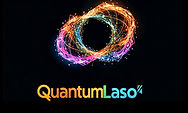How a single developer, leveraging AI, quantum hardware, and open science, can rival the tools once reserved for billion-dollar pharma companies.
- mansour ansari

- Sep 4
- 4 min read
My Journey into Quantum-Enhanced Simulation and Drug Discovery
Over the past several years, I have immersed myself in a wide range of disciplines — mathematics, algebra, Newtonian physics, quantum physics, artificial intelligence, and quantum computing. After five years of concentrated study, I do not claim the title of Ph.D. expert, but I have built the ability to digest, analyze, and apply complex knowledge in these fields. Where I lack depth, I seek guidance from experts. Where I excel is in stitching together code, designing large systems, and making disparate technologies work as one.
I have spent over 30 years designing complex platforms in media, TV, emergency management, and communications. That experience gives me the resilience and creativity to build systems in new domains like quantum computing and AI — not as an academic, but as a practical system designer in the new era of AI.
Discovering Quantum Randomness
While studying quantum computing, I came across Quantum Random Number Generators (QRNGs) . Unlike pseudorandom number generators (PRNGs), which are deterministic algorithms built into classical simulations, QRNGs derive randomness from fundamental quantum processes — photon detection, entanglement, and measurement at the smallest scales.
For decades, simulations across industries — oil and gas, finance, chemistry, physics, atmospheric science — have relied on PRNGs to initialize Monte Carlo-style models. Every iteration begins with a seed: a random number that sets the trajectory for the simulation. The quality of that seed determines what parts of the search space are explored.
Replacing PRNGs with QRNGs allows a simulation to probe deeper, less deterministic regions of parameter space. In simple terms, PRNG is like rolling a die with slightly predictable patterns; QRNG is like rolling a die governed by the true uncertainty of nature. This difference becomes particularly critical in simulations that require exploring vast, multidimensional search spaces.
From Tornado Forecasting to Drug Discovery
My first experiment was with tornado forecasting. By injecting QRNG data into NOAA atmospheric datasets, I was able to anticipate collapse zones and vorticity earlier than radar could detect. That gave me confidence that quantum entropy adds real value to classical simulations.
The next challenge I took on was drug discovery.
Molecular Docking Explained:
Molecular docking is a computational method used to predict how a ligand (a small molecule) fits into a protein receptor’s binding site. The goal is to estimate whether a compound might bind strongly enough to influence the protein’s function — the foundation of drug discovery.
Docking involves several steps:
1. Protein Preparation
Proteins (from the Protein Data Bank, PDB) must be cleaned, protonated, and prepared. Binding sites are identified, and receptor grids are generated to define where ligands can fit.
2. Ligand Preparation
Molecules (often in SMILES format) are converted into 3D conformers. Hydrogens are added, stereochemistry defined, and torsional (angular deformation) flexibility is set.
3. Pose Generation
The ligand is rotated, translated, and bent inside the protein binding site. Millions of potential poses exist.
4. Scoring
Each pose is evaluated using a scoring function that estimates binding affinity in kcal/mol, as well as hydrogen bonds, hydrophobic interactions, and steric clashes. Lower scores usually indicate stronger binding.
I currently use AutoDock Vina, one of the most widely known docking engines. Vina generates poses and binding affinity scores efficiently, balancing accuracy and speed. It is open-source, which makes it ideal for experimentation and integration.
QuantumCURE Pro — My System
I designed QuantumCURE Pro to combine molecular docking with quantum-enhanced randomness and retrosynthesis engines. The pipeline works as follows:
Retrosynthesis (via ASKCOS, MIT)
Generates possible synthesis pathways for a given molecule, recommends reagents, and evaluates feasibility and safety. Normally, this planning might take chemists hours or days. With ASKCOS inside QuantumCURE, results appear in minutes.
Docking (via AutoDock Vina)
Accepts ligands in SMILES format, docks them against chosen protein targets, and outputs binding affinity, protein interaction maps, and drug-likeness scores. Importantly, I can run docking with quantum entropy seeds, classical PRNG seeds, or a hybrid — enabling side-by-side comparisons.
Entropy and Glyphs (Zaban Framework)
Each run is tagged with glyphs and collapse scores, symbolic representations of entanglement patterns. This is not only a scientific record but also a symbolic dictionary that AI can later use to interpret collapse dynamics.
Export data
Results are exportable in JSON or CSV, including synthesis queries, retrosynthesis outputs, docking affinities, collapse scores, and provenance metadata.
Why Free API Keys?
Most commercial retrosynthesis engines, like SYNTHIA® , require expensive licenses and API keys. As a solo developer and citizen scientist, I wanted to create something open and accessible. By integrating ASKCOS (MIT), which is free and academically validated, I have a baseline engine that works without licensing hurdles. Later, I can add commercial engines like SYNTHIA as premium options, giving users multiple synthesis back-ends inside one platform.
Where I Am Heading
QuantumCURE is stabilizing into a multi-engine, quantum-enhanced discovery system. With a few clicks, I can now:
Dock molecules against curated protein targets
Generate retrosynthesis plans in minutes
Score compounds by binding affinity, quantum collapse metrics, and feasibility
Export results for AI or lab integration
The vision is to expand this platform into a citizen-science-powered drug discovery network, where contributors worldwide run lightweight simulations from their own devices, upload results, and collectively accelerate cancer research and beyond.
QuantumCURE is not just a tool — it’s a demonstration that a single developer, leveraging AI, quantum hardware, and open science, can rival the tools once reserved for billion-dollar pharma companies.
If you like to know more, check my websites:
Contact? videomover@gmail.com





Comments